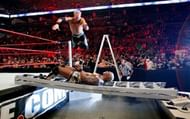#2 It sparked a trend toward more "extreme" wrestling

The WWE of the 1980s and early 90s bared little resemblance to the Attitude and Ruthless Aggression eras that would come to define the company for the next generation of fans. In fact, 1995's RAW and pay-per-view events rarely featured anything even close to the high-flying, furniture-heavy stunts that would become normalized in subsequent years.
Vince McMahon, content with promoting a family-friendly, mainstream product, eschewed the dangerous bumps popularized in Memphis, other territories, and Japan. Instead, he focused on larger-than-life, wacky characters and mostly traditional storytelling to drive fan interest.
Did The Rock's "Final Boss" run hurt WWE? Watch Here!
With Big Daddy Cool and the Hitman (as well as Paul Heyman's ECW promotion) proving foreign objects and table bumps could be safely used to elevate the product to another level, the WWF of 1996-1997 gradually began to allow more extreme manuevers as part of various major feuds (Undertaker vs. Mankind, Triple H vs. Mankind, Stone Cold vs. Bret Hart, and so on).
Even just a month after Survivor Series '95, Hart would "draw color" by bleeding from the forehead in his match with the British Bulldog at In Your House: Seasons Beatings, something that was even more rare at the time than weapons.
Today, WWE is practically reliant on these over-the-top human demolition scenes, but a retrospective view of pay-per-view main events on the WWE Network reveals that this came about as a gradual progression, and it all started with Diesel/Hart.
Make Sportskeeda your preferred choice for WWE content by clicking here: Source preferences

